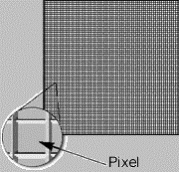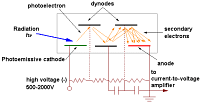Photon counting detectors for astronomy
 The detector is to the telescope as the retina is to the eye. Without them we see nothing and are blind. The telescope is the instrument that gathers the light from the stars and planets and the detector is that which captures it, photon by photon. With this stored data we can create images, route out information, learn all we can about the dynamics of the stars we want to look at, and hypothesize some more about what goes on inside them. We make theories about what's happening in every part of the star, from its core to its outermost points, and then gleam what information we can about them through our telescopes and detectors. The knowledge we gain through these instruments go to proving, disproving and improving the theories we have, as well as sparking off new interest in something we may not have thought of before. The detector is to the telescope as the retina is to the eye. Without them we see nothing and are blind. The telescope is the instrument that gathers the light from the stars and planets and the detector is that which captures it, photon by photon. With this stored data we can create images, route out information, learn all we can about the dynamics of the stars we want to look at, and hypothesize some more about what goes on inside them. We make theories about what's happening in every part of the star, from its core to its outermost points, and then gleam what information we can about them through our telescopes and detectors. The knowledge we gain through these instruments go to proving, disproving and improving the theories we have, as well as sparking off new interest in something we may not have thought of before.
 Here in the Advanced Imaging Research Group we have several detectors at our disposal, each unique in its way, each with its own talent for picking out a certain type of light, or for storing light in a particular way. These items are the MAMA camera (Multi Anode Microchannel-plate Array), our CCDs (Charge Coupled Device) and our APDs (Avalanche Photo Diode). Further to this we have a digital camera, not for scientific use, but it's handy to have around. We use these detectors in different configurations to suit our scientific interests and take them to a telescope (good spots are in the Canaries, Chile, Hawaii, and sometimes Russia). An observation run may only be for one night, or as long as a couple of weeks if we get really lucky. The norm is at most 3 or 4 nights at the most sought after telescopes. Here in the Advanced Imaging Research Group we have several detectors at our disposal, each unique in its way, each with its own talent for picking out a certain type of light, or for storing light in a particular way. These items are the MAMA camera (Multi Anode Microchannel-plate Array), our CCDs (Charge Coupled Device) and our APDs (Avalanche Photo Diode). Further to this we have a digital camera, not for scientific use, but it's handy to have around. We use these detectors in different configurations to suit our scientific interests and take them to a telescope (good spots are in the Canaries, Chile, Hawaii, and sometimes Russia). An observation run may only be for one night, or as long as a couple of weeks if we get really lucky. The norm is at most 3 or 4 nights at the most sought after telescopes.
How the MAMA camera works

The MAMA camera is our main observing device that we use for most of our science work. It's a beauty. Not much to look at but what it can do is of incredible value to our line of work. Our theorists like to work on pulsars, stars that give off rhythmic pulses of light, made totally from neutrons and spinning as fast as 500 times per second. These pulsars are very far away and so are very faint in the night sky, invisible to the naked eye. Astronomers want this light captured and recorded and imaged so they can dissect the information and look for the pulses (along with anything and everything else) with the computers. So in we bring the MAMA, which can detect very low light levels (a lot lower than the human eye can) and image that which it is pointed at.
A microchannel plate sits on a multianode array, hence the MAMA name. Light in the form of photons (hv in the diagram above) approach the front of the detector. They strike either a photocathode or the side of one of the channels in the microchannel plate and one electron is released which is drawn down into the plate. As it ricochets down through the channel more electrons are knocked out from atoms and released producing at the bottom a huge shower of a few million electrons that land in a small spot on the anodes. Because of the crisscross pattern of the anodes we can know where this spot of electrons hit. The crossing of the anodes are the pixels of the detector, each pixel is 22mm wide, and the total size is 1024x256 pixels. Hence we now have an X and Y position for this one spot of electrons, which is the same as the spot on the photocathode for the initial photon. We can attach a time of arrival to the spot of electrons and so for every photon we collect we give it a position and a time-tag. We can build up an image in this way by attaching the camera to a computer (through lots of electronics first) and see what's happening. At the end, we have huge files containing the position and time of arrival of every photon we caught. We use our own software to decipher this file and pick out what information we can about the stars from which the photons came.
How the CCD camera works
 We have several CCD cameras, each made by different companies, with different pixel sizes, and with different numbers of pixels, but they all work in the same way, based on the same basic principle. We have several CCD cameras, each made by different companies, with different pixel sizes, and with different numbers of pixels, but they all work in the same way, based on the same basic principle.
A CCD is constructed of thousands of pixels (which can be as small as 15mm across) each made from a semiconducting material, such as silicon. When a light photon hits a pixel in the CCD, an electron is freed from a silicon atom, and this is held in the pixel with the use of a slight voltage. As more photons hit, more electrons are released and held. Thus by counting the number of electrons sitting in a pixel we know how much light hit that pixel, and so we can draw an image on a computer monitor. A problem with this is that it takes time to read all the pixels in a CCD (which can have as many as 1024x1024 pixels and more), plus pixels can become full with electrons and overflow into neighbouring pixels if there is too much light hitting the CCD, which will blur the image. Several CCDs can be placed alongside each other to create large mosaic detector for creating wide-field images.
How the APD camera works
The APD is different again from the others cameras, the big thing being that it has only one pixel. What use can that be? It's a special pixel that can see a wavelength of light the other cameras cannot, that light being infrared. And why not have lots of pixels together? That's a production problem that weighs heavily on some scientists and manufacturers but which is being tackled daily, in order that some time soon APD arrays will be produced. This pixel is a semiconducting material again, but larger than the CCD pixels with a usual size of 180mm/200mm across. It detects light the best when that light has a wavelength of about 700nm, although it can see light from 400nm up to 1000nm (just not as well as the centre wavelengths).
How the PMT works
 The photomultiplier tube (or PMT) is a device that provides extremely high sensitivity and ultra-fast response. A typical photomultiplier tube consists of a photoemissive cathode (photocathode), followed by focussing electrodes, called dynodes and an anode in a vacuum tube. Photomultipliers are highly sensitive photon detectors. The word Photomultiplier is actually a misnomer, the device does not multiply photons (like an optical amplifier would), but it actually multiplies electrons (liberated by photons). Unlike many other optoelectronic detectors, PM tubes actually have a resolution down to single photons. This is achieved through an application of the well known Photoelectric Effect first explained by Albert Einstein. The photomultiplier tube (or PMT) is a device that provides extremely high sensitivity and ultra-fast response. A typical photomultiplier tube consists of a photoemissive cathode (photocathode), followed by focussing electrodes, called dynodes and an anode in a vacuum tube. Photomultipliers are highly sensitive photon detectors. The word Photomultiplier is actually a misnomer, the device does not multiply photons (like an optical amplifier would), but it actually multiplies electrons (liberated by photons). Unlike many other optoelectronic detectors, PM tubes actually have a resolution down to single photons. This is achieved through an application of the well known Photoelectric Effect first explained by Albert Einstein.
When light is incident on the face of the PMT the photocathode emits photoelectrons into the vacuum. The photoelectrons are accelerated towards the series of dynodes, which are maintained at successively higher potentials with respect to the cathode. On striking the dynode surface, each electron causes the emission of several secondary electrons, which are in turn accelerated towards the next dynode and continue the multiplication process. Thus if on average d secondary electrons are emitted at each dynode surface for each incident electron and there are N dynodes overall, then the total current amplification factor is given byG=dN
Considerable amplification can be achieved. Due to this secondary emission multiplication, photomultiplier tubes provide extremely high sensitivity and exceptionally low noise and large photosensitive areas.
|

